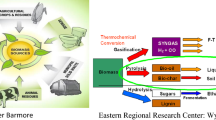Abstract
The microbial degradation of hard coal implies the cleavage of diaryl ether linkages in the coal macromolecule. We investigated the biodegradation of diphenylether as a model compound representing this substructure of coal. A bacterial strain isolated from soil and identified as Pseudomonas cepacia, was able to grow with diphenylether as sole source of carbon. During microbial growth, three metabolites were detected in the culture supernatant by high pressure liquid chromatography. As product of ring hydroxylation and subsequent rearomatization, 2,3-dihydroxydiphenylether was identified by UV, mass and nuclear magnetic resonance spectrometry and gas chromatography analyses. The cleavage of the ether linkage led to the formation of phenol and 2-pyrone-6-carboxylic acid, the latter being not further degraded by Pseudomonas cepacia. The possible cleavage mechanism of the ether linkage is discussed.
Similar content being viewed by others
Abbreviations
- DPE:
-
diphenylether
- PCA:
-
2-pyrone-6-carboxylic acid
- GC:
-
gas chromatography
- MS:
-
mass spectrometry
- HPLC:
-
high pressure liquid chromatography
References
Bernhardt FH, Ruf HH, Staudinger H, Ullrich V (1971) Purification of a 4-methylbenzoate O-demethylase from Pseudomonas putida. Hoppe-Seyler's Z Physiol Chem 352:1091–1099
Black TH (1983) The preparation and reactions of diazomethane. Aldrichimica Acta 16:3–10
Cartwright NJ, Smith AW (1967) Bacterial attack on phenolic ethers. Biochem J 102:826–841
Codner RC (1969) Solid and solidified growth media in microbiology. In: Norris JR, Ribbons DW (eds) Methods in microbiology, vol 1. Academic Press, New York London, pp 427–454
Cohen MS, Gabriele PD (1982) Degradation of coal by the fungi Polyporus versicolor and Poria placenta. Appl Environ Microbiol 44:23–27
Cohen MS, Bowers WC, Aronson H, Gray Jr ET (1987) Cell-free solubilization of coal by Polyporus versicolor. Appl Environ Microbiol 53:2840–2843
Donnelly MI, Dagley S (1980) Production of methanol from aromatic acids by Pseudomonas putida. J Bacteriol 142: 916–924
Donnelly MI, Dagley S (1981) Bacterial degradation of 3,4,5-trimethoxycinnamic acid with production of methanol. J Bacteriol 147:471–476
Eaton WE, Ribbons DW (1982) Metabolism of dibutylphthalate and phthalate by Micrococcus sp. strain 12B. J Bacteriol 151:48–57
Eaton WE, Ribbons DW (1987) Biotransformation of 3-methylphthalate by Micrococcus sp. strain 12B. J Gen Microbiol 133:2473–2476
Fakoussa RM (1981) Kohle als Substrat für Mikroorganismen: Untersuchungen zur mikrobiellen Umsetzung nativer Steinkohle. Ph. D. Thesis. Friedrich-Wilhelms-Universität Bonn, FRG
Gamar Y, Gaunt JK (1971) Bacterial metabolism of 4-chloro-2-methylphenoxyacetate. Biochem J 122:527–531
Heitkamp MA, Freeman JP, Miller DW, Cerniglia CE (1988) Pyrene degradation by a Mycobacterium sp.: Identification of ring oxidation and ring fission products. Appl Environ Microbiol 54:2556–2565
Heredy LA, Wender I (1980) Model structure for a bituminous coal. Am Chem Soc, Div Fuel Chem 25:38–45
Kersten PJ, Dagley S, Whittaker JW, Arciero DM, Lipscomb JD (1982) 2-Pyrone-4,6-dicarboxylic acid, a catabolite of gallic acids in Pseudomonas species. J Bacteriol 152:1154–1162
Klein J, Beyer M, van Afferden M, Hodek W, Pfeifer F, Seewald H, Wolff-Fischer E, Jüntgen H (1988) Coal in biotechnology. In: Rehm H-J, Reed G (eds) Biotechnology, vol 6 b. Verlag Chemie, Weinheim, pp 497–567
Lowry OH, Rosebrough NJ, Farr AG, Randall RJ (1951) Protein measurement with the Folin-phenol reagent. J Biol Chem 193:265–275
Luckenbach R (1987) Beilstein: Handbook of organic chemistry. 5th Suppl Ser, vol 8. Springer Berlin Heidelberg New York
Müller R, Lingens F (1980) Enzymatische Bildung und Isolierung von 2-Hydroxymuconsäure, ein Metabolit im bakteriellen Abbau des Herbizids Chloridazon. Z Naturf 35c:346–347
Müller R, Haug S, Eberspächer J, Lingens F (1977) Catechol-2,3-Dioxygenase aus Pyrazon-abbauenden Bakterien. Hoppe Seyler's Z Physiol Chem 358:797–805
Pfennig N, Lippert KD (1966) Über das Vitamin-B12-Bedürfnis phototropher Schwefelbakterien. Arch Mikrobiol 55: 245–256
Pieper HP, Reineke W, Engesser KH, Knackmuss HJ (1988) Metabolism of 2,4-dichlorophenoxyacetic acid, 4-chloro-2-methylphenoxyacetic acid and 2-methylphenoxyacetic acid by Alcaligenes eutrophus JMP 134. Arch Microbiol 150: 95–102
Pyne JW, Stewart DL, Fredrickson J, Wilson BW (1987) Solubilization of leonardite by an extracellular fraction from Coridus versicolor. Appl Environ Microbiol 53:2844–2848
Ribbons DW (1970) Stoichiometry of 3-O-demethylase activity in Pseudomonas aeruginosa. FEBS Lett 8:101–104
Saeki YS, Nozaki M (1980) Cleavage of pyrogallol by non-heme iron-containing dioxygenases. J Biol Chem 255:8465–8471
Scott CD, Strandberg GW, Lewis SN (1986) Microbial degradation of coal. Biotechnol Prog 2:131–139
Strandberg GW, Lewis SN (1987) Solubilization of coal by an extracellular product from Streptomyces setonii 75 Vi2. J Ind Microbiol 1:317–375
Tack BF, Chapman PJ, Dagley S (1972) Metabolism of gallic acid and syringic acid by Pseudomonas putida. J Biol Chem 247: 6438–6443
Takase I, Omori T, Mindoda Y (1986) Microbial degradation products from biphenyl-related compounds. Agric Biol Chem 50:681–686
Ward B (1985) Lignite-degrading fungi isolated from a weathered outcrop. Syst Appl Microbiol 6:236–238
Author information
Authors and Affiliations
Rights and permissions
About this article
Cite this article
Pfeifer, F., Schacht, S., Klein, J. et al. Degradation of diphenylether by Pseudomonas cepacia . Arch. Microbiol. 152, 515–519 (1989). https://doi.org/10.1007/BF00425479
Received:
Accepted:
Issue Date:
DOI: https://doi.org/10.1007/BF00425479




